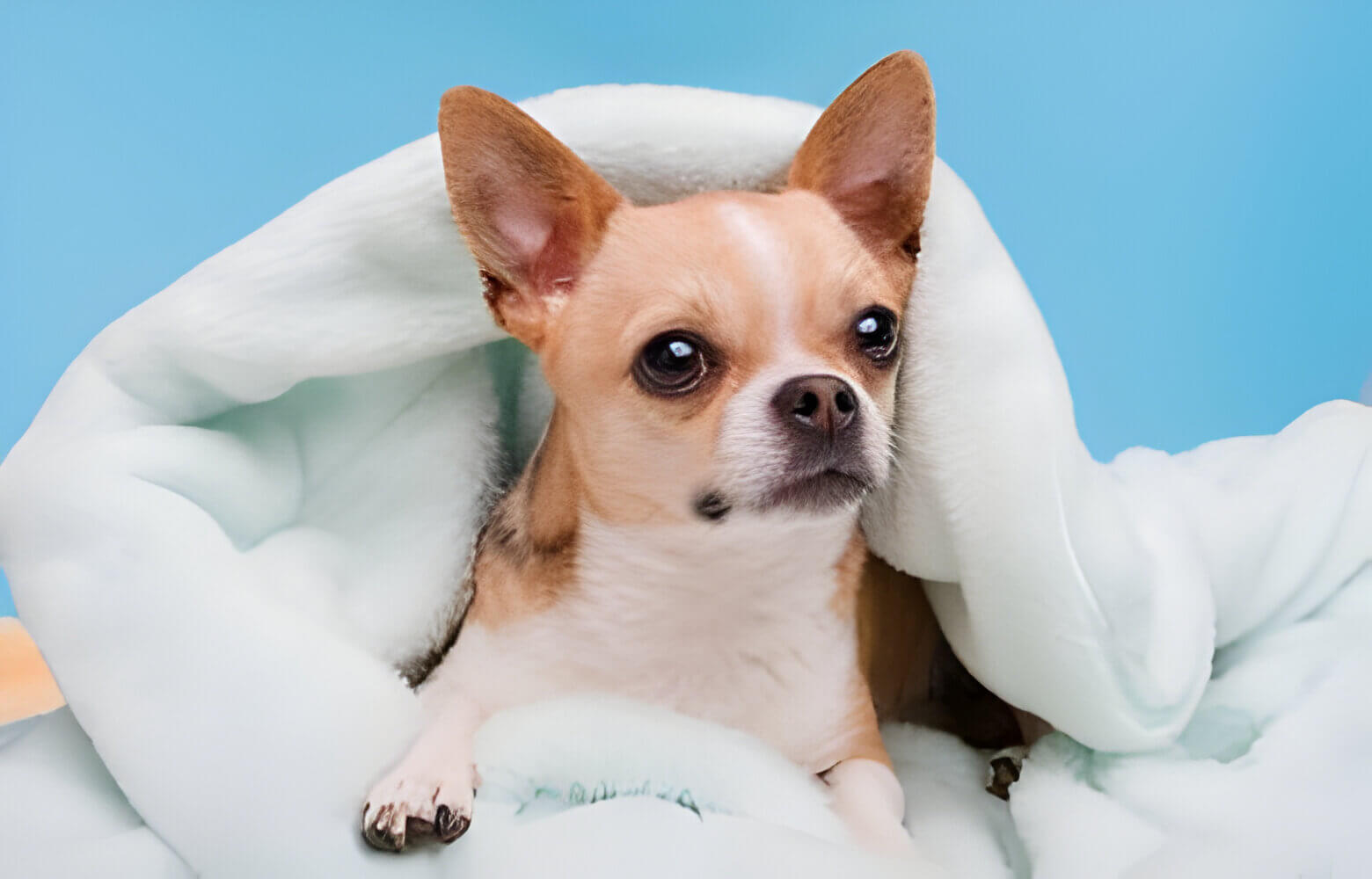Wondering how long your Chihuahua stays in heat and what to expect during this time? This can be a confusing and messy period for both you and your furry friend. But fear not, pawrents! This comprehensive guide will shed light on the intricacies of the Chihuahua heat cycle, equipping you with the knowledge and tools to navigate this natural biological process with ease.

Understanding the Chihuahua Heat Cycle
The reproductive cycle of a female Chihuahua, often referred to as the “heat cycle,” is a central aspect of canine biology that every Chihuahua owner should be familiar with.
What is the Chihuahua heat cycle?
The heat cycle, scientifically known as the estrous cycle, encompasses the period when a female Chihuahua becomes receptive to mating and can conceive puppies. This cycle is marked by significant hormonal changes that prepare the dog’s body for potential pregnancy. It’s a natural process that occurs in all female dogs who haven’t been spayed, including Chihuahuas.
When Do Chihuahuas Go in Heat for the First Time
Female Chihuahuas typically begin their heat cycle around 6 to 12 months of age, although it can vary depending on individual health, size, and breed specifics. Some may experience their first cycle sooner or even later than this range. It’s essential to note that the onset of the heat cycle signifies that your Chihuahua is reaching sexual maturity, but it does not necessarily mean she is ready or should be bred during her first cycle.
How Long Does a Chihuahua Stay in Heat
The average duration of the heat cycle for Chihuahuas is about 3 weeks but can range from 2 to 4 weeks. Each cycle is unique, and variations in length are perfectly normal.
How Often Do Chihuahuas Go into Heat
Chihuahuas, like most small breeds, may experience heat cycles more frequently than larger breeds, typically every 6 months. However, individual dogs may have cycles that occur slightly more or less often, ranging anywhere from 2 to 3 cycles per year.
Typical Chihuahua Heat Cycle
The heat cycle can be broken down into four main stages:
- Proestrus: Lasting between 7 to 10 days, this first stage is marked by visible signs such as swelling of the vulva and a bloody vaginal discharge, yet the female is not yet receptive to males. You may also notice behavioral changes, such as clinginess or agitation.
- Estrus: Often considered the “actual heat,” estrus lasts between 5 and 10 days as well. It’s during this phase that the female is receptive to males and capable of conceiving. The discharge lightens in color and decreases in amount.
- Diestrus: Following estrus, diestrus signals the end of the female’s receptiveness. Whether pregnant or not, her body behaves as though it is, lasting about 60 days. The signs of heat recede, and physiological and behavioral normalcy returns.
- Anestrus: This final phase is a period of inactivity between heat cycles, lasting around 4 to 6 months. There are no outward signs of heat during anestrus as the body rests and prepares for the next cycle.
Understanding these stages helps Chihuahua owners anticipate and manage their pet’s needs during each phase of the heat cycle, from behavioral adjustments to recognizing the optimal time for breeding.
Table: Stages of the Chihuahua Heat Cycle
| Stage | Duration (Approximate) | Key Hormonal Changes | Physical Signs | Behavioral Changes |
|---|---|---|---|---|
| Proestrus | 7 to 10 days | Increasing estrogen levels | Vulvar swelling, bloody discharge (may be light) | Increased urination, restlessness |
| Estrus (Standing Heat) | 5 to 10 days | Peak estrogen levels | More pronounced vulvar swelling, reddish discharge | Increased affection, attracting mates, marking territory (possible aggression) |
| Diestrus | 60 to 100 days | Decreasing estrogen, progesterone rise | Vulva returns to normal size, discharge disappears | Reduced receptiveness to mating, nesting behavior (in some cases) |
| Anestrus | 4 to 6 months | Low hormonal activity | No visible signs | No outward signs of heat |
Signs and Symptoms to Watch For: How to Know if Your Chihuahua is in Heat
Recognizing the signs and symptoms of your Chihuahua’s heat cycle will help you provide proper care and navigate this natural biological process. Here’s a breakdown of what to expect:
Physical Signs to Watch For During Each Stage
- Proestrus:
- Swelling of the Vulva: This is usually the first sign of heat, indicating the beginning of the proestrus stage.
- Vaginal Bleeding: The discharge is initially bright red and gradually lightens. The amount can vary significantly between individuals.
- Estrus:
- Continued Vulvar Swelling: Swelling remains but is coupled with a change in the discharge, which becomes lighter and may be straw-colored.
- Flagging: Female Chihuahuas may display a behavior known as flagging, where they lift their tail to one side, indicating they are receptive to males.
- Diestrus and Anestrus:
- During these stages, physical signs of heat recede. Any continued discharge or persistent swelling should be evaluated by a veterinarian as this is not typical for the diestrus or anestrus stages.
Behavioral Changes
- Increased Affection or Clinginess: Your Chihuahua might seek more attention from you or become more affectionate.
- Restlessness or Anxiety: Some Chihuahuas become uneasy or appear to be looking for something.
- Urine-marking: Even well-house-trained Chihuahuas may start marking indoors.
- Aggression: Even the sweetest Chihuahuas can exhibit aggression towards other dogs, especially other females.
False Pregnancy
As part of their cycle, some Chihuahuas might exhibit signs of a false pregnancy, such as nesting behavior, mothering inanimate objects, and even lactation. If you suspect a false pregnancy, it’s wise to consult your veterinarian to confirm the condition and discuss ways to manage these behaviors.
When to Seek Veterinary Attention
While the heat cycle is a natural process for your Chihuahua, certain symptoms warrant immediate veterinary care:
- Excessive Bleeding: If the bleeding seems heavier than a typical heat cycle or lasts longer than expected.
- Prolonged Heat Signs: Signs of heat that extend beyond the usual 2-4 week period.
- Signs of Illness: Lethargy, loss of appetite, or any behavior that is unusual for your Chihuahua during her cycle.
How To Care for Your Chihuahua During Her Heat Cycle
Proper care during your Chihuahua’s heat cycle is critical to ensuring her comfort and health, and minimizing potential complications.

Heat Cycle Hygiene and Cleanliness
Good hygiene and cleanliness are crucial during this period, primarily because of the vaginal bleeding associated with the heat cycle:
- Managing Bleeding: To manage the bleeding and keep your home clean, consider using protective measures such as puppy pads for her favorite spots or canine heat cycle diapers. Choose products that are specifically designed for smaller breeds like Chihuahuas, ensuring a snug fit without causing discomfort.
- Keeping Your Chihuahua Comfortable: Regular grooming can help keep her coat clean from any discharge. A damp washcloth can be used to gently clean her vulva area if necessary. Be sure to be gentle and patient as they can experience heightened sensitivity during this time.
- Regular Bedding Changes: Ensure frequent changes of her bedding to provide a clean, dry space. This can help in preventing potential infections and any skin irritation caused by the discharge.

Preventing Unwanted Breeding
As a responsible Chihuahua owner, it is essential to prevent unwanted pregnancies:
- Supervise Outdoors: Never leave your Chihuahua unsupervised when outdoors. Male dogs are incredibly persistent and can detect a female in heat from miles away.
- Leash Walks: Always keep your Chihuahua on a leash when outside. This will help you control her movements and ensure that no male dogs can get close to her.
- Isolation from Male Dogs: It would be best if you isolated her from any male dogs in your household, as mating can occur quickly.
What NOT to Do During Heat
- Avoid Bathing: While it may be tempting to bath your pet to clean up discharge, it’s generally advised to avoid bathing during the heat cycle, especially when bleeding is most significant.
- Breeding on First Heat: Breeding your Chihuahua on her first heat is typically discouraged to allow your pet’s body to fully mature, reducing potential risks and complications. It’s better to wait for at least the third cycle when her body is fully developed and ready for the challenges of pregnancy.
- No Over-Exertion: Some Chihuahuas may seem a little more lethargic during their heat. It’s entirely normal. Avoid enforcing intense physical activities and let her set the pace.
Managing your Chihuahua’s heat cycle may seem overwhelming, especially if this is your first time. However, with patience, care, and these tips in mind, you can ensure that your beloved pet is healthy and comfortable throughout her cycle.
Long-Term Considerations
For Chihuahua owners, managing the heat cycle is a regular part of pet care which requires diligence and understanding. However, there are long-term considerations to keep in mind that can influence the overall well-being of your Chihuahua. One of the most significant decisions pet owners can make is choosing to spay their dog.
Spaying as a Solution
Spaying, or ovariohysterectomy, is a surgical procedure that removes a female dog’s ovaries and usually the uterus, making her incapable of reproducing. This operation not only prevents future heat cycles but also eliminates the risk of unplanned pregnancies, contributing to pet population control.
Benefits of Spaying
There are several health benefits associated with spaying your Chihuahua:
- Reduced Risk of Mammary Cancer: Spaying before the first heat significantly lowers the risk of mammary gland tumors, which are malignant in about half of dogs.
- Prevention of Pyometra: Spaying eliminates the risk of pyometra, a potentially life-threatening uterine infection that can occur in older, unspayed females.
- Longevity: Studies suggest that spayed dogs tend to have a longer lifespan compared to those who are unspayed, possibly due to the reduction in certain health risks.
When to Consider Spaying
The ideal age for spaying a Chihuahua can vary. Traditionally, spaying is recommended between 6 to 9 months of age, which may be before or after a Chihuahua experiences her first heat, depending on her individual development. Recent studies and evolving veterinary perspectives suggest early spaying, even at 4 to 6 months, can be beneficial and safe.
However, the timing should be a decision made in partnership with your veterinarian. Factors to consider include overall health, breed, and lifestyle. For example, some studies suggest waiting until after the first heat may be beneficial for certain breeds or sizes of dogs to reduce the risk of orthopedic problems and some cancers, though these benefits must be weighed against the increased risk of mammary cancer and the surgical risk in older or overweight dogs.
Making the Decision
Deciding to spay your Chihuahua is a significant and personal choice that impacts her health and wellbeing. It’s important to discuss with your veterinarian to understand the full spectrum of benefits and risks based on your Chihuahua’s specific needs. This informed decision can not only potentially extend her lifespan but also eliminate certain health risks, allowing her to live a more comfortable, carefree life.
Conclusion
Throughout this guide, we’ve explored the intricacies of the Chihuahua heat cycle. From understanding the hormonal changes and stages to recognizing the signs and symptoms, you’re now equipped to provide the best possible care for your Chihuahua during this time.
Remember, maintaining cleanliness, preventing unwanted breeding, and consulting your veterinarian with any concerns are key to a smooth experience. With this newfound knowledge, you can confidently navigate the Chihuahua heat cycle and ensure your furry friend remains happy and healthy throughout this natural biological process.
FAQs on Chihuahua Heat Cycle
Q. Can a Chihuahua get pregnant during her first heat cycle?
Yes, a Chihuahua can become pregnant during her first heat cycle. Even though she is still physically and mentally immature, her body is capable of carrying a pregnancy. Experts generally advise against allowing a Chihuahua to become pregnant during her first heat for health reasons.
Q. Is it normal for a Chihuahua to have irregular heat cycles?
Yes, it can be normal for Chihuahuas, especially in their first couple of years, to have irregular heat cycles. Small breeds like Chihuahuas may have more frequent cycles (twice or more per year), while others might not settle into a regular pattern right away. Consult a veterinarian if her cycles are irregularly close together, excessively far apart, or if there are other signs of concern.
Q. What are the signs of a silent heat in Chihuahuas, and how common is it?
Silent heat, where the usual signs of being in heat are minimal or absent, can occur in Chihuahuas but is not highly common. Signs may include a sudden interest from male dogs without visible swelling of the vulva or bleeding. If suspected, a vet can confirm a silent heat through hormonal testing or physical examination.
Q. Are there any health risks associated with a Chihuahua going through multiple heat cycles without being bred?
Yes, there are health risks, including an increased chance of mammary tumors and pyometra (a severe uterine infection) with each successive heat cycle. Spaying can significantly reduce these risks.
Q. How can I help my Chihuahua feel more comfortable during her heat cycle?
Measures to help your Chihuahua feel more comfortable include providing a quiet, cozy resting area, using doggy diapers to manage discharge, gently brushing her coat, and maintaining a calm environment. Be patient with her mood changes and offer extra attention and comfort.
Q. How long should I wait after my Chihuahua’s heat cycle ends before considering breeding or spaying/neutering?
For breeding, consulting with a vet to determine the best timing based on health, age, and breed standards is crucial. If choosing to spay, it’s often recommended to wait until at least two to three months after the heat cycle has ended to reduce the risk of surgical complications, but your vet can provide guidance tailored to your dog’s health and circumstances.
References:
https:// www.msdvetmanual.com/multimedia/table/estrous-heat-cycle-in-female-dogs
https:// www.akc.org/expert-advice/health/do-dogs-have-periods/
